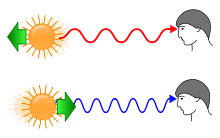The Doppler effect (or Doppler shift), named after the Austrian physicist Christian Doppler, who proposed it in 1842 in Prague, is the change in frequency of a wave (or other periodic event) for an observer moving relative to its source. It is commonly heard when a vehicle sounding a siren or horn approaches, passes, and recedes from an observer. Compared to the emitted frequency, the received frequency is higher during the approach, identical at the instant of passing by, and lower during the recession.
When the source of the waves is moving toward the observer, each successive wave crest is emitted from a position closer to the observer than the previous wave. Therefore each wave takes slightly less time to reach the observer than the previous wave. Therefore the time between the arrival of successive wave crests at the observer is reduced, causing an increase in the frequency. While they are travelling, the distance between successive wave fronts is reduced; so the waves “bunch together”. Conversely, if the source of waves is moving away from the observer, each wave is emitted from a position farther from the observer than the previous wave, so the arrival time between successive waves is increased, reducing the frequency. The distance between successive wave fronts is increased, so the waves “spread out”.
Astronomy
Redshift of spectral lines in the optical spectrum of a supercluster of distant galaxies (right), as compared to that of the Sun (left)
The use of the Doppler effect for light in astronomy depends on our knowledge that the spectra of stars are not homogeneous. They exhibit absorption lines at well defined frequencies that are correlated with the energies required to excite electrons in various elements from one level to another. The Doppler effect is recognizable in the fact that the absorption lines are not always at the frequencies that are obtained from the spectrum of a stationary light source. Since blue light has a higher frequency than red light, the spectral lines of an approaching astronomical light source exhibit a blueshift and those of a receding astronomical light source exhibit a redshift.
Redshift and blueshift
Example

Doppler effect, yellow (~575 nm wavelength) ball appears greenish (blueshift to ~565 nm wavelength) approaching observer, turns orange (redshift to ~585 nm wavelength) as it passes, and returns to yellow when motion stops. To observe such a change in color, the object would have to be traveling at approximately 5200 km/s, or about 75 times faster than the speed record for the fastest manmade space probe.
Among the nearby stars, the largest radial velocities with respect to the Sun are +308 km/s (BD-15°4041, also known as LHS 52, 81.7 light-years away) and -260 km/s (Woolley 9722, also known as Wolf 1106 and LHS 64, 78.2 light-years away). Positive radial velocity means the star is receding from the Sun, negative that it is approaching.
Candela Citations
- Provided by: Wikipedia. Located at: http://en.wikipedia.org/wiki/Doppler_effect. License: CC BY-SA: Attribution-ShareAlike
- Provided by: Wikipedia. Located at: http://en.wikipedia.org/wiki/Redshift. License: CC BY-SA: Attribution-ShareAlike

